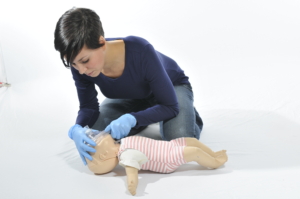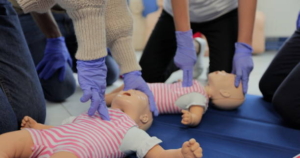Infant CPR:
A Life-Saving Skill Every Parent Should Know
Introduction
One essential skill every parent, caregiver, or anyone who spends time with infants should possess is Infant CPR (Cardiopulmonary Resuscitation). Alert First Aid has trained over 100,000 people in infant CPR. In this article, we’ll delve into the importance of Infant CPR, step-by-step instructions on how to perform it, and answer some common questions.
What Is Infant CPR?
Understanding the Basics
Infant CPR is a potentially life-saving technique used in emergencies when a baby (usually under the age of one) stops breathing or experiences a sudden cardiac arrest. This procedure involves a combination of chest compressions and ventilations to maintain blood circulation and oxygenation to vital organs until professional medical help arrives. In real simple term we are giving the infant some air via ventilations and we are moving it around via compressions
When Should You Use Infant CPR?

Recognizing the Signs
Infant CPR is necessary when an infant is unresponsive and not breathing or breathing abnormally. Abnormal breathing means if you see that the baby is blue or struggling for air. This can happen due to various reasons, including choking, drowning, sudden infant death syndrome (SIDS), or severe allergic reactions. Being able to recognize the signs is crucial for a timely response.
How to Perform Infant CPR
Step-by-Step Instructions
Infant CPR can be stressful, but having a clear understanding of the steps involved can make a significant difference in a life-threatening situation. Although we can show a video and break down the steps, that is not substitution for regular practice. Think about trying to learn how to tie shoelaces by watching a video and reading instructions. This is a skill that needs to be practiced. Practice can be done at home with a doll or even a stuffed animal. If you are a new parent or caregiver you can also take an Emergency Childcare First Aid Course Here’s a step-by-step guide:
Step 1: Ensure Safety
Before approaching the infant, ensure that the environment is safe for both you and the baby. Remove any potential hazards if possible. Here is a quick rhyme that will help your remember hazards ) Glass, Gas, Fire, Wire, Thug, Bugs.
Step 2: Check Responsiveness
Gently tap the infant on the bottom of the foot and shout to check if they respond. If there is no response, immediately proceed to the next step.
Step 3: Call for Help
Dial 911 or your local emergency number to request professional medical assistance. If someone else is present, ask them to make the call while you start CPR. Remember time is of the essence. Use your speaker phone when calling 911 and continue to do CPR while on the phone with 911
Step 4: Begin Compressions
Place the infant on a firm surface, usually on their back. Use two fingers (not your entire hand) to give gentle, rhythmic chest compressions at a rate of 100-120 per minute. Compress the chest about 1.5 inches deep.
Step 5: Administer Rescue Breaths
After 30 compressions, give two gentle rescue breaths by covering the infant’s mouth and nose with your mouth and providing enough air to make their chest rise. Remember infants have very small lungs only use the air in your cheeks to breath into an infant
Step 6: Continue CPR
Repeat the cycle of 30 chest compressions followed by two rescue breaths until the baby starts breathing, emergency medical personnel arrive, or you are physically unable to continue.
Common Questions About Infant CPR
1. Can I hurt the baby while performing CPR?
No, using the correct technique minimizes the risk of injury. Focus on providing chest compressions and rescue breaths as instructed.
2. How fast should I perform chest compressions?
Maintain a pace of 100-120 compressions per minute to be effective.
3. Should I perform CPR if the baby is coughing or gagging?
If the baby is coughing or gagging, encourage them to continue coughing. Only perform CPR if they become unresponsive.
4. Can I use an AED (Automated External Defibrillator) on an infant?
AEDs are typically designed for adults and older children. Use pediatric pads or follow manufacturer instructions if available for infants.
5. What if I can’t remember the steps during an emergency?
It’s normal to feel overwhelmed, but doing something is better than nothing. Focus on providing chest compressions if you’re unsure about rescue breaths.
Conclusion
Infant CPR is a crucial skill that can save lives in emergency situations involving infants. Learning the proper technique and understanding when to use it can make a significant difference in the outcome. Remember, it’s always better to be prepared and never have to use this skill than to be unprepared in a life-threatening situation.
Here is Our Free Infant CPR Video
Alert First Aid offers regular first aid and CPR in Victoria, Nanaimo, Vancouver and Burnaby.


